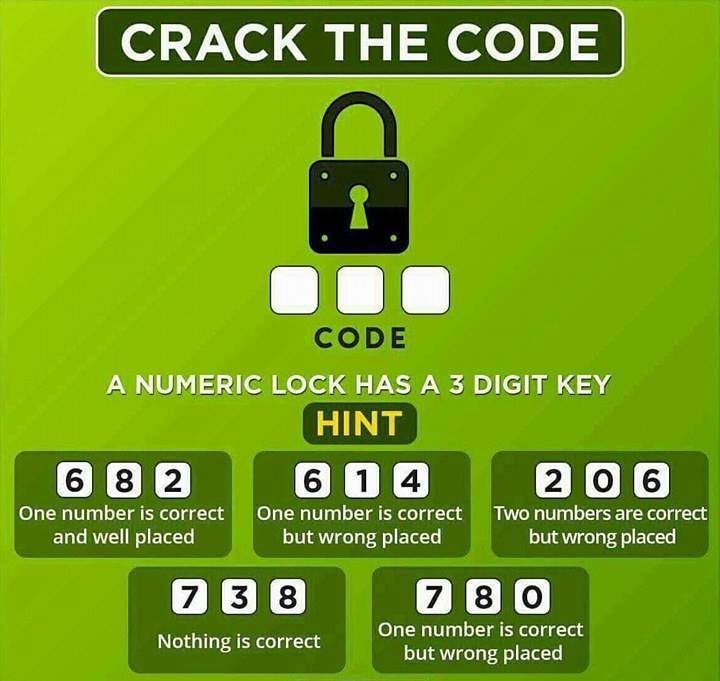I just started learning prolog and I'm stuck trying to solve this puzzle :

I tried to add some rules like this example http://swish.swi-prolog.org/example/houses_puzzle.pl but I couldn't come up with a solution.
What I tried so far:
% Render the houses term as a nice table.
:- use_rendering(table,
[header(h('N1', 'N2', 'N3'))]).
numbers(Hs) :-
length(Hs, 1),
member(h(6,8,2), Hs),
member(h(6,1,4), Hs),
member(h(2,0,6), Hs),
member(h(7,3,8), Hs),
member(h(7,8,0), Hs),
correct_and_placed(6, 8, 2, Hs).
correct_and_place(A, B, C, R).
But I don't even know how to write a rule that can check if a number is correct and on the right place.
To the existing answers, I would like to add a version using CLP(FD) constraints.
The two building blocks I shall use are num_correct/3 and num_well_placed/3.
First, num_correct/3, relating two lists of integers to the number of common elements:
num_correct(Vs, Ns, Num) :-
foldl(num_correct_(Vs), Ns, 0, Num).
num_correct_(Vs, Num, N0, N) :-
foldl(eq_disjunction(Num), Vs, 0, Disjunction),
Disjunction #<==> T,
N #= N0 + T.
eq_disjunction(N, V, D0, D0 #\/ (N #= V)).
Sample query:
?- num_correct([1,2,3], [3,5], Num). Num = 1.
As is characteristic for pure relations, this also works for much more general queries, for example:
?- num_correct([A], [B], Num). B#=A#<==>Num, Num in 0..1.
Second, I use num_well_placed/3, which relates two lists of integers to the number of indices where corresponding elements are equal:
num_well_placed(Vs, Ns, Num) :-
maplist(num_well_placed_, Vs, Ns, Bs),
sum(Bs, #=, Num).
num_well_placed_(V, N, B) :- (V #= N) #<==> B.
Again, a sample query and answer:
?- num_well_placed([8,3,4], [0,3,4], Num). Num = 2.
The following predicate simply combines these two:
num_correct_placed(Vs, Hs, C, P) :-
num_correct(Vs, Hs, C),
num_well_placed(Vs, Hs, P).
Thus, the whole puzzle can be formulated as follows:
lock(Vs) :-
Vs = [_,_,_],
Vs ins 0..9,
num_correct_placed(Vs, [6,8,2], 1, 1),
num_correct_placed(Vs, [6,1,4], 1, 0),
num_correct_placed(Vs, [2,0,6], 2, 0),
num_correct_placed(Vs, [7,3,8], 0, 0),
num_correct_placed(Vs, [7,8,0], 1, 0).
No search at all is required in this case:
?- lock(Vs). Vs = [0, 4, 2].
Moreover, if I generalize away the last hint, i.e., if I write:
lock(Vs) :-
Vs = [_,_,_],
Vs ins 0..9,
num_correct_placed(Vs, [6,8,2], 1, 1),
num_correct_placed(Vs, [6,1,4], 1, 0),
num_correct_placed(Vs, [2,0,6], 2, 0),
num_correct_placed(Vs, [7,3,8], 0, 0),
* num_correct_placed(Vs, [7,8,0], 1, 0).
then the unique solution can still be determined without search:
?- lock(Vs). Vs = [0, 4, 2].
In fact, I can even also take away the penultimate hint:
lock(Vs) :-
Vs = [_,_,_],
Vs ins 0..9,
num_correct_placed(Vs, [6,8,2], 1, 1),
num_correct_placed(Vs, [6,1,4], 1, 0),
num_correct_placed(Vs, [2,0,6], 2, 0),
* num_correct_placed(Vs, [7,3,8], 0, 0),
* num_correct_placed(Vs, [7,8,0], 1, 0).
and still the solution is unique, although I now have to use label/1 to find it:
?- lock(Vs), label(Vs). Vs = [0, 4, 2] ; false.
I hope there are better ways but...
You can implement "one number is correct and well placed" as follows
oneRightPlace(X, Y, Z, X, S2, S3) :-
\+ member(Y, [S2, S3]),
\+ member(Z, [S2, S3]).
oneRightPlace(X, Y, Z, S1, Y, S3) :-
\+ member(X, [S1, S3]),
\+ member(Z, [S1, S3]).
oneRightPlace(X, Y, Z, S1, S2, Z) :-
\+ member(X, [S1, S2]),
\+ member(Y, [S1, S2]).
For "one number is correct but wrong placed, you can use
oneWrongPlace(X, Y, Z, S1, S2, S3) :-
member(X, [S2, S3]),
\+ member(Y, [S1, S2, S3]),
\+ member(Z, [S1, S2, S3]).
oneWrongPlace(X, Y, Z, S1, S2, S3) :-
member(Y, [S1, S3]),
\+ member(X, [S1, S2, S3]),
\+ member(Z, [S1, S2, S3]).
oneWrongPlace(X, Y, Z, S1, S2, S3) :-
member(Z, [S1, S2]),
\+ member(X, [S1, S2, S3]),
\+ member(Y, [S1, S2, S3]).
For "two number are correct but wrong placed", you can write
twoWrongPlace(X, Y, Z, S1, S2, S3) :-
member(X, [S2, S3]),
member(Y, [S1, S3]),
\+ member(Z, [S1, S2, S3]).
twoWrongPlace(X, Y, Z, S1, S2, S3) :-
member(X, [S2, S3]),
member(Z, [S1, S2]),
\+ member(Y, [S1, S2, S3]).
twoWrongPlace(X, Y, Z, S1, S2, S3) :-
member(Y, [S1, S3]),
member(Z, [S1, S2]),
\+ member(X, [S1, S2, S3]).
And, for "nothing is correct", become simply
zeroPlace(X, Y, Z, S1, S2, S3) :-
\+ member(X, [S1, S2, S3]),
\+ member(Y, [S1, S2, S3]),
\+ member(Z, [S1, S2, S3]).
Now you can put all togheter and write
member(S1, [0, 1, 2, 3, 4, 5, 6, 7, 8, 9]),
member(S2, [0, 1, 2, 3, 4, 5, 6, 7, 8, 9]),
member(S3, [0, 1, 2, 3, 4, 5, 6, 7, 8, 9]),
oneRightPlace(6, 8, 2, S1, S2, S3),
oneWrongPlace(6, 1, 4, S1, S2, S3),
twoWrongPlace(2, 0, 6, S1, S2, S3),
zeroPlace(7, 3, 8, S1, S2, S3),
oneWrongPlace(7, 8, 0, S1, S2, S3).
obtaining (in S1, S2 and S3) the right solution.
The preceding examples are written without the use of clp(fd), that I don't know well but that (I suppose) can semplify a lot.
If you love us? You can donate to us via Paypal or buy me a coffee so we can maintain and grow! Thank you!
Donate Us With